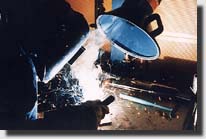| BIA | TUV |
 |
|
Dust category ½Øè¹
Dust exists from visible and invisible, floating and settled parts of solid material. The larger the parts, the less they float; when the parts are very small, the dust will be in the air permanently and will not settle. Contact with dust can cause disease, in these cases where:
- the concentration is very high;
- the particles are small enough to penetrate into the nose or even in the smallest lung alveolus's;
- the dust contains poisonous elements which can cause diseases on short notice;
- the dust contains poisonous elements which can cause diseases such as cancer on the long term.
The vacuum cleaner division according to BIA ZH 1/487
A short time ago in principle 6 vacuum cleaner categories were known, namely: U, S, G, C, K1, K2 and B1.
Important conceptions are:
- MAK or MAC value = maximum working place concentration. This figure is put in the maximal allowed quantity milligrams dust per m³ working place (mg/m³).
- Permeability respectively filtration of the filter. This is put in percentages.
- Load of the filter area. This is put in the maximal quantity cubical meters air which is extracted through 1 m² filter material for one hour (m³/m²/h).
The following scheme clarifies the aforementioned:
| Dust category | suitable for dry, not inflammable, health hazardous dust | permeability in % | filtration in % | max. allowed load per m² filter area |
| U | with MAK value > 1 mg/m³ | < 5 % | > 95 % | < 500 m³/m²/h |
| S | with MAK value > 1 mg/m³ | < 1 % | > 99 % | < 200 m³/m²/h |
| G | with MAK value < 0,1 mg/m³ | < 0,5 % | > 99,5 % | < 200 m³/m²/h |
| C | with MAK value < 0,1 mg/m³ of cancer rousing dust of group II and III (1) | < 0,1 % | > 99,9 % | < 200 m³/m²/h |
| K1 | with all MAK values of cancer rousing dust of groups I/II and III (2) | < 0,05 % | > 99,95 % | < 200 m³/m²/h |
| K2 | with disease rousers | < 0,05 % | > 99,95 % | < 200 m³/m²/h |
| B1 of the dust explosion classes St1 and St2
in Zone 11. Dust explosion dangerous dust can also be divided in the
groups S, G, C or K.
|
||||
- Filtering in the last phase according to floatdust filter class S in accordance with DIN24184.
- Industrial vacuum cleaners for group K2 are in practice not attainable because in this group it concerns moulds and so on, which should mean that the whole filter system should be renewed every time directly after use.
